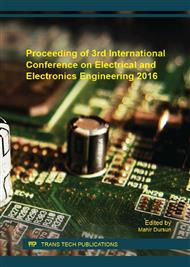[1]
L. Mishra, P. K. Datta and R. Pradhan, Modeling of Wavelength Conversion Using Switching Bistability in a Vertical Cavity Semiconductor Saturable Absorber, International Journal of Electronics and Electrical Engineering, 3, 396 (2015).
DOI: 10.12720/ijeee.3.5.396-401
Google Scholar
[2]
G. D. Cole, E. S. Björlin, , Q. Chen, Chung-Yeung Chan, S. Wu, C. S. Wang, N. C. MacDonald, and J. E. Bowers, MEMS-Tunable Vertical-Cavity SOAs, IEEE Journal of Quantum Electronics, 41, 390 (2005).
DOI: 10.1109/jqe.2004.841496
Google Scholar
[3]
O. Qasaimeh, Effect of Doping on the Optical Characteristics of Quantum Dot Semiconductor Optical Amplifiers. IEEE J. Lightwave Tech. 27, 1978 (2009).
DOI: 10.1109/jlt.2008.2005589
Google Scholar
[4]
L. Mishra, R. Pradhan , P.K. Datta, Modeling of two wavelength switching using a reflective vertical cavity semiconductor saturable absorber, Optics Communications, 331, 267 (2014).
DOI: 10.1016/j.optcom.2014.06.020
Google Scholar
[5]
Antonio Hurtado, Ian D. Henning, and Michael J. Adams, Bistability and nonlinear gain in 1. 55mm vertical cavity semiconductor optical amplifiers: Theory and experiments, Applied Phys. Lett. 91, 151106 (2007).
DOI: 10.1063/1.2798053
Google Scholar
[6]
C. F. Marki, D. R. Jorgesen, H. Zhang, P. Wen, and S. C. Esener, Observation of counterclockwise, clockwise and butterfly bistabilty in 1550 nm VCSOAs, Optics Express, 15, 4953 (2007).
DOI: 10.1364/oe.15.004953
Google Scholar
[7]
A. Hurtado, A. Gonzalez-Marcos, and J. A. Martin-Pereda, Modeling Reflective Bistability in Vertical-Cavity Semiconductor Optical Amplifiers, IEEE Journal of Quantum Electronics, 41, 376 (2005).
DOI: 10.1109/jqe.2004.841500
Google Scholar
[8]
E.S. Bjorlin, T. Kimura, Q. Chen, C. Wang and J.E. Bowers, High output power 1540nm vertical cavity semiconductor optical amplifiers, ELECTRONICS LETTERS, 40, 704 (2004).
DOI: 10.1049/el:20040097
Google Scholar
[9]
E. Staffan Björlin, Toshio Kimura, and John E. Bowers, Carrier-Confined Vertical-Cavity Semiconductor Optical Amplifiers for Higher Gain and Efficiency, IEEE J. of Selected Topics in Quantum Electronics, 9, 1374 (2003).
DOI: 10.1109/jstqe.2003.819480
Google Scholar
[10]
P. Royo, R. Koda, and L. A. Coldren, Vertical Cavity Semiconductor Optical Amplifiers: Comparison of Fabry–Pérot and Rate Equation Approaches, IEEE Journal of Quantum Electronics, 38, 279 (2002).
DOI: 10.1109/3.985569
Google Scholar


